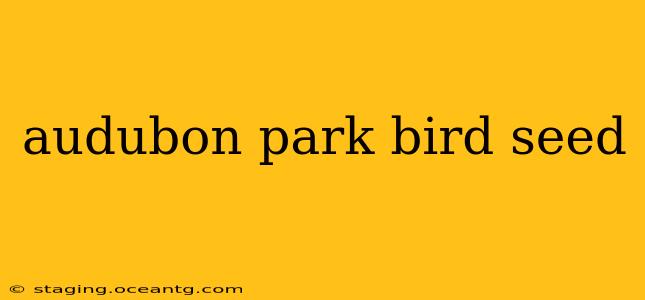Audubon Park, with its lush greenery and diverse habitats, is a haven for birdwatchers. But to truly maximize your birdwatching experience and contribute to the local avian ecosystem, providing the right bird seed is crucial. This guide dives deep into the world of Audubon Park bird seed, exploring the best types of seed, feeding techniques, and how to create a bird-friendly paradise.
What's the Best Bird Seed for Audubon Park Birds?
The ideal bird seed for Audubon Park depends on the specific birds you want to attract. Different species have different dietary preferences. However, a good blend typically includes:
- Black oil sunflower seeds: These are a favorite among many bird species, including cardinals, chickadees, and jays. They're high in fat and offer excellent energy.
- Nyjer (thistle) seeds: These tiny seeds are particularly appealing to finches, goldfinches, and siskins. They're best offered in specialized feeders to prevent waste.
- White-striped sunflower seeds: Larger than black oil sunflower seeds, these are enjoyed by a wider variety of birds, including larger species.
- Milo: This grain is a good source of energy for ground-feeding birds like doves and sparrows.
- Cracked corn: Another good option for ground-feeding birds, though it might attract less desirable species like pigeons in large quantities.
Avoid fillers like wheat and oats, which many birds won't eat. Look for high-quality blends from reputable brands, focusing on seeds with minimal fillers and high nutritional value.
What Kind of Bird Feeders Should I Use in Audubon Park?
The type of feeder you choose impacts which birds you'll attract. Consider these options:
- Tube feeders: These are ideal for dispensing sunflower seeds and nyjer seeds, allowing multiple birds to feed simultaneously.
- Hopper feeders: These larger feeders hold a substantial amount of seed, suitable for a variety of seeds and attracting a broader range of species.
- Platform feeders: These are excellent for ground-feeding birds and offer easy access to seed. However, they can also attract larger, more aggressive birds.
- Suet feeders: Suet provides high-energy nourishment, especially important during cold months. It attracts woodpeckers, nuthatches, and other insectivores.
Remember to clean your feeders regularly to prevent the spread of disease.
What are the Best Places to Put Bird Feeders in Audubon Park?
Placement is key to attracting a diverse array of birds. Consider these factors:
- Visibility: Choose locations visible to you, allowing for enjoyable birdwatching.
- Shelter: Position feeders near trees or shrubs for protection from predators and inclement weather.
- Accessibility: Ensure the feeders are easily accessible for refilling and cleaning.
- Avoid obstructions: Keep feeders away from windows to prevent bird collisions.
Are There Any Regulations Regarding Bird Feeding in Audubon Park?
It's crucial to check with Audubon Park's official guidelines regarding bird feeding. Regulations may vary depending on the specific park area and time of year. Responsible feeding practices that minimize waste and prevent the spread of disease are essential.
What Time of Year is Best for Bird Feeding in Audubon Park?
Bird feeding is beneficial year-round, but it's especially important during colder months when natural food sources are scarce. Supplementing their diet during migration periods can also help fuel their journeys.
How Can I Make My Audubon Park Bird Feeding Area More Attractive to Birds?
Beyond providing the right seed and feeders, consider these enhancements:
- Water source: Provide a birdbath or shallow dish of water for drinking and bathing.
- Nesting materials: Place natural materials like twigs, pine cones, and shredded bark nearby to encourage nesting.
- Native plants: Planting native shrubs and trees provides natural food sources, shelter, and nesting sites.
By following these guidelines, you can create a thriving bird habitat in Audubon Park and enjoy countless hours of rewarding birdwatching. Remember, responsible and informed bird feeding contributes significantly to the well-being of these magnificent creatures.
